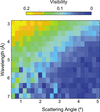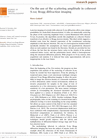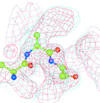issue contents
June 2021 issue

Cover illustration: Different options to represent crystal lattice features in the program CALM, a new software for the determination of lattice parameters from the positions and widths of Kikuchi bands in a diffraction pattern: (top left) gnomonic projection, (top right) stereographic projection and (bottom) edge-filtered Funk transform. Courtesy of Nolze et al. [J. Appl. Cryst. (2021), 54, 1012–1022].
research papers
Open  access
access
 access
access
Hydrogen-bonding parameters are modelled with different methods of quantum crystallography. The underlying model assumptions are analysed and related to the refinement results.
Comprehensive ray-tracing simulations of the output beam parameters over all possible combinations of the asymmetry angles of a four-bounce assembly composed of Ge(111) and Ge(220) monolithic channel-cut X-ray monochromators allowed the design and manufacture of a monochromator assembly optimized for the highest photon flux density at a particular detector distance behind the assembly. Comparative small-angle X-ray scattering and high-resolution X-ray diffraction measurements revealed up to one order of magnitude higher transmittance compared with traditional symmetric and asymmetric Ge(220) Bartels monochromators, while high beam collimation was still maintained.
Download citation


Download citation


A method is presented to determine the distribution of polymer brush structures that are in agreement with collected neutron reflectometry data, while minimizing assumptions about the shape of the brush profile.
A measurement of the self-diffusion of water is presented, using the high-resolution neutron scattering technique modulated intensity small-angle neutron scattering (MI-SANS). This technique uses two tuned radio frequency flippers to create a modulation in the neutron intensity that can resolve dynamics on the picosecond time scale.
Download citation


Download citation


Examples of range-dependent disorder and layer disorder models are applied to synchrotron X-ray total scattering data of a zeolitic imidazolate framework (ZIF-8).
Download citation


Download citation


The use of the non-negative matrix-factorization technique is validated for automatically extracting physically relevant signals from atomic pair distribution function data in the context of in situ measurement with a newly developed software infrastructure.
Download citation


Download citation


Open  access
access
 access
access
A new automated method to solve organic crystal structures from scratch by a fit to the pair distribution function, without prior knowledge of lattice parameters and space group, has been developed.
Download citation


Download citation


Solid–solid phase transitions in adenine riboswitch crystals are characterized using atomic force microscopy and polarized video microscopy.
The forward problem of coherent X-ray Bragg diffraction imaging is revisited, with particular attention paid to the heterogeneous incident field. Some approximations that are often implicit in the literature are quantified on characteristic examples.
Download citation


Download citation


Open  access
access
 access
access
Satellites generated by small dislocation loops in polycrystalline proton- or neutron-irradiated Zr alloys are characterized by X-ray line profile analysis. The convolutional multiple whole-profile procedure has been extended to characterize irradiation-induced satellites around fundamental Bragg peaks.
This paper reports the implementation of an infrared furnace, suitable for in situ single-crystal neutron diffraction, working at temperatures of up to 1000°C with different and adjustable partial gas pressures up to 2 bar.
Download citation


Download citation


Open  access
access
 access
access
Anomalous small-angle X-ray scattering (ASAXS) allows one to obtain information about the spatial distribution of specific atoms in a sample, but its application to dilute biological samples is challenging because of weak anomalous effects. ASAXS experiments from dilute solutions of ferritin and cobalt-loaded apoferritin near the resonance X-ray K edges of Fe and Co, respectively, have been performed at the P12 bioSAXS beamline of the EMBL at PETRA III synchrotron, DESY.
Download citation


Download citation


Open  access
access
 access
access
Design and use of a sapphire single-crystal gas-pressure cell for in situ neutron powder diffraction
A gas-pressure cell for in situ neutron powder diffraction based on a sapphire single crystal is described. Materials information, technical drawings and instructions for use are included.
A nondestructive X-ray laboratory method was developed to enable determination of the static Debye–Waller factor distribution along the z axis for porous layers, which further allows the quantification of the porosity gradient. Accordingly, grazing-incidence X-ray diffraction at different incidence angles was employed to obtain a wide range of X-ray penetration depths down to the interface of a porous silicon layer with the substrate.
An investigation of the precision, accuracy and confidence of the whole pattern (WP) and Williamson–Hall (WH) methods of crystallite size determination has given insight into the long-standing debate on the quantitative capability of X-ray diffraction for estimating crystallite size. The WP method demonstrated precision, accuracy and confidence, allowing quantitative crystallite size determinations to be made. The WH method demonstrated precision in its crystallite size determination, but it was also found to be less accurate, resulting in consistently low values, with a broad confidence from an ill-posed inverse problem.
Download citation


Download citation


The texture measurement capabilities of the NOMAD beamline at the Spallation Neutron Source and the NRSF2 beamline at the High Flux Isotope Reactor at Oak Ridge National Laboratory are discussed. Texture analyses using two common analysis methods, Rietveld texture analysis using the MAUD program and pole figure inversion using the MTEX MATLAB toolbox, are presented.
Download citation


Download citation


The step size, angular range and intensity of X-ray powder diffraction data and the number and type of refinable parameters have been examined with respect to their effect on quantitative phase analysis by the Rietveld method.
Download citation


Download citation


Open  access
access
 access
access
A novel aerosol device for protein crystal complexation using ultrasonic vibrations is described.
The position and shape of Bragg edges in wavelength-resolved neutron transmission spectra depend on the crystal structure and on the crystallographic texture of the material. This work describes a novel method to obtain integral parameters of the orientation distribution function from these spectra with the aim of estimating material properties.
Download citation


Download citation


The multipurpose four-circle diffractometer in Tel Aviv University is described. The design, the beam quality (flux/divergence) and the application of the diffractometer for various tasks for in situ X-ray crystallography of functional materials are demonstrated.
Download citation


Download citation


A combined specular and off-specular neutron reflectometry analysis algorithm on an absolute scale is presented. Experimental data from thermally annealed immiscible polymer bilayer systems are fitted.
Download citation


Download citation


Contrast-variation (ultra)-small-angle neutron scattering [(U)SANS] of vulcanized poly(styrene-ran-butadiene) (SBR) rubber has clarified that ZnO clusters surrounded by dense networks of SBR exist in the rubber. The size of the ZnO clusters is of the order of 1000 Å.
Open  access
access
 access
access
The paper describes an algorithm and formalism for visualizing neutron diffraction data from the Alignment Facility diffractometer at ISIS. Their use is demonstrated by performing test measurements on the piezoelectric PbMg1/3Nb2/3O3.
Download citation


Download citation


Human insulin polymorphism upon 4-chlororesorcinol or 4-bromoresorcinol binding and pH variation is investigated.
short communications
Download citation


Download citation


A complete X-ray polarization-switch effect of silicon crystals at the exact multiple-beam diffraction geometry is reported. It will be very helpful for designing novel crystal-based polarizers to achieve a 90° polarization rotation of incident X-rays.
Download citation


Download citation


An incommensurately modulated structure zone in the α-Zr matrix of forged Zircaloy-4 alloy was investigated by transmission electron microscopy and related techniques.
computer programs
Open  access
access
 access
access
The program lamaGOET serves as an interface between quantum-mechanical and crystallographic refinement software to enhance the flexibility of the quantum-crystallographic methods Hirshfeld atom refinement and X-ray constrained wavefunction fitting.
Download citation


Download citation


The program SHELIXIR enables searching for the correct space group, optimal solvent content, and high- or low-resolution limits, and parallelization of SHELXE procedures.
Open  access
access
 access
access
CrystalExplorer is a native cross-platform program for the visualization and investigation of molecular crystal structures.
Download citation


Download citation


Open  access
access
 access
access
New software and algorithms for the accurate measurement of crystal lattice parameters from Kikuchi bands in a diffraction pattern are presented.
addenda and errata
Free 

Free 

Errors in the article by Smilgies [J. Appl. Cryst. (2019), 52, 247–251] are corrected.
crystallographers
Free 

Free 



 journal menu
journal menu
























































